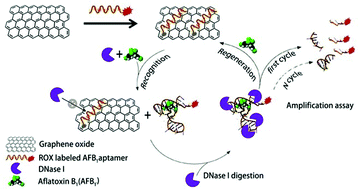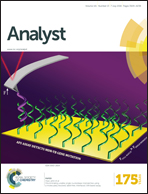Size-dependent modulation of graphene oxide–aptamer interactions for an amplified fluorescence-based detection of aflatoxin B1 with a tunable dynamic range
Abstract
Aflatoxin B1 (AFB1) is a common toxin found in many foods. While AFB1 sensors have been reported, few studies have shown amplified detection with tunable dynamic ranges. We herein report a simple and highly sensitive amplified aptamer-based fluorescent sensor for AFB1, which relies on the ability of nano-graphene oxide (GO) to protect aptamers from nuclease cleavage for amplified detection and on the nanometer size effect of GO to tune the dynamic range and sensitivity. The assay was performed by simply mixing the carboxyl-X-rhodamine (ROX)-labeled AFB1 aptamer, the GO, the nuclease, and the AFB1 samples. Modulating the size of the GO nanosheet resulted in three dynamic ranges, i.e., 12.5 to 312.5 ng mL−1, 1.0 to 100 ng mL−1, and 5.0 to 50 ng mL−1, with corresponding limits of detection of 10.0 ng mL−1, 0.35 ng mL−1 and 15.0 ng mL−1, respectively. The sensor was highly selective against other aflatoxins and common molecules in foods, and its performance was verified in corn samples spiked with known concentration of AFB1.



 Please wait while we load your content...
Please wait while we load your content...